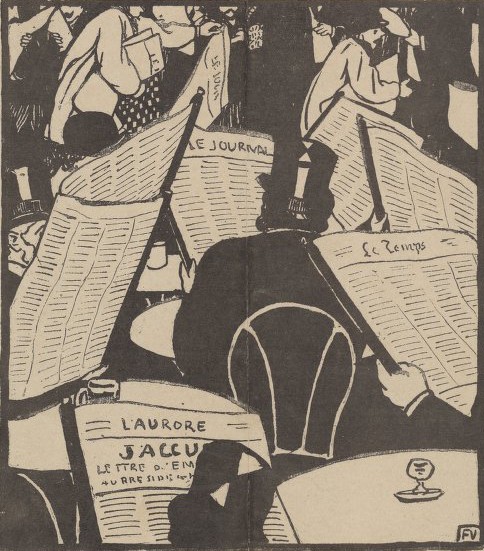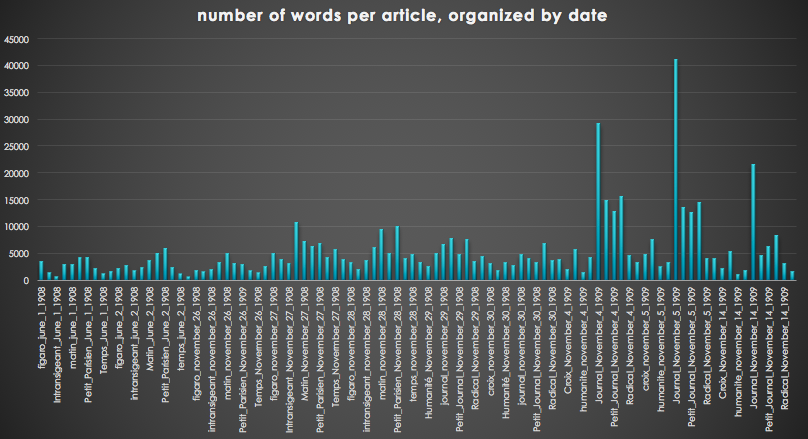
What is the language of scandal? This is a question I have been working on over the past two summers with Sam Gibson and Megan Doherty, two Washington and Lee undergraduates, as well Brandon Walsh and Sarah McEleney, both at UVA. This is a first of a series of posts that uses text analysis to explore the press coverage of the Steinheil Affair, a scandal that riveted France in 1908 and 1909.
Through these posts, we’re hoping to do two things:
- Examine the dynamics of the Steinheil Affair in particular and the press culture of the time more generally, with an eye to what makes a scandal a scandal.
- Think about the ways in which text analysis be used to examine a particular corpus — in this case, a set of newspapers articles about the same series of events.
Scholars have examined how scandals allow for opportunities to reaffirm and/or debate norms – and early 20th century France provides a fascinating test case to examine how a scandal functioned in a particular cultural context. Paris in the Belle Époque had a vibrant and highly competitive press culture in which journalists vied to get the latest scoops and feed a public eager for tales of crime, violence and misbehavior. And in this era, elites were in theory subject to codes of respectability and propriety but in practice a great deal was permitted as long as it was not too public or flagrant. So what happened when elite misdeeds became public within the context of a scandal?
In this milieu, Marguerite Steinheil was easily one of the most infamous women of the day. She was a noted salon hostess and the wife of a painter, but her fame rested on her position mistress of the French president Félix Faure, who had a fatal stroke in 1899 during one of their sexual encounters. In the decade after his death, she had affairs with many wealthy and powerful men who supported her struggling household financially. On the night of May 30/31, 1908, her life was upended when her husband and mother were found murdered in their home. Mme Steinheil survived the attack and spent the next six months framing innocent individuals and telling outlandish lies to mislead the police and the public. In November 1908, after it was revealed that she had planted evidence on one of her servants that had implicated him in the double-murder, she was arrested and became the state’s chief suspect. One year later, she was tried for the crime and acquitted after a ten-day trial. The case served up a tale of sex, violence and elite misbehavior – and unsurprisingly was constantly in the news from the time of the double murder to Mme Steinheil’s acquittal.
Together, we been using the tools and techniques of text analysis that are common in the digital humanities – as well as a fair amount of plain, old fashioned reading – to explore the newspaper coverage of the Steinheil Affair. Some of the questions we are asking are:
- What messages about the meaning of the affair was the press conveying on different dates?
- How did a scandal function in the context of the time?
- How did the press report (or not) on politicians’ sexual indiscretions?
- How did the coverage of the affair change over time?
- How did different newspapers, according to their political positions and markets, report differently on the affair?
We will use methods that range from the basic (word counts) to the more complex (topic modeling and clustering) – and so have an opportunity to think about how these different techniques can be used. But in general, we’re less interested in pushing the envelope in terms of what is possible with text analysis and more interested in talking about the dynamics of the Steinheil Affair.
Our sources and methods
The articles that we examine come from ten different newspapers on ten different days that were crucial turning points in the affair. We chose the four major mass circulation dailies of the era: Le Journal, Le Matin, Le Petit Journal, and Le Petit Parisien, all of which billed themselves of essentially apolitical and which were known for their sensationalist coverage of crime and scandals. Six additional newspapers represent a variety of political positions (La Croix, Le Figaro, L’Instransigeant on the right; Le Temps on the center-left; and Le Radical and L’Humanité on the left).
We chose the following dates that were key moments in the unfolding of the scandal:
- June 1, 1908 and June 2, 1908 (right after the news of the double-murder broke)
- November 26, 1908 (after it became clear that Mme Steinheil had framed Rémy Couillard, the Steinheil’s valet who was then the chief suspect)
- November 27, 1908, the day when newspapers reported that Mme Steinheil had been imprisoned
- November 28, 29 and 30, 1908, when revelations about her sexual indiscretions came tumbling out
- November 4 and 5, 1909, during which newspapers were reporting on the first two days of Mme Steinheil’s trial
- November 14, 1909, which contained reporting on the last day of the trial
Altogether, this gave us a total of 98 articles to examine (because La Croix did not publish on Sundays, there are no June 1, 1908 or November 29, 1908 issues for this newspaper).
All the newspapers have been digitized and are on the Bibliothèque nationale’s site. Most, but not all, of the articles have been OCRed – but all needed at least some degree of cleaning up. This took up the vast majority of our time, although the laborious process of correcting OCR allowed us to read the articles more closely that we might have otherwise and develop the set of questions that we wanted to ask.
Once we had all the articles, we explored these texts using a variety of pre-existing tools (Voyant, Antconc) as well as natural language processing in Python (our GitHub repository can be found here).
In the posts to follow, we’ll be exploring various topics in the coverage of this scandal, primarily proceeding chronologically and/or thematically as opposed to by tool or methodology. I’ll be doing most of the writing, but Megan and Sam have agreed to take over for some of the posts.
When was the affair big news — and for whom?
By way of an introduction to the themes we’ll be discussing, here are some thoughts on when the scandal was most interesting to journalists (and their presumed readers):

This shows all 98 articles, with the size of each circle illustrating the size of their word counts. What is apparent is that the longest articles are from the dates of the trial (November 1909) and especially from the mass press (those four high-circulation dailies: Le Journal, Le Matin, Le Petit Journal, Le Petit Parisien). Indeed, Le Journal reproduced the testimony from the trial word-for-word; all four newspapers increased their regular length by at least two pages to report on the trial. Clearly the trial was a big event for them and they were willing to alter their production costs with the expectation of a higher readership. Here’s another visualization of the same data, this time organized by date.

This highlights the degree to which the mass press typically offered more coverage of the Steinheil Affair than other, more politically oriented newspapers, across all dates.
But if we look beyond the issue of the mass press’s interest in covering a sensational case, there are other dynamics at play. Of the three sets of dates (June 1908, November 1908 and November 1909), the case was seen as the least interesting in its earliest days, right after the double-murder was discovered. The number of words was also relatively low on November 26, 1908, but there is a quite sudden increase in interest the next day. And in this instance, it wasn’t just the mass press that devoted a lot of space to the case; even Le Temps, the least sensationalist of the major newspapers, did, as well (5686 words, which is not that much less than Le Petit Journal’s coverage, at 6316 words). On November 27, 1908, the lowest word count came from La Croix (2638 words) and the highest was from Le Journal (10816 words, about four times as many words). This relatively high level of interest among all newspapers was also sustained on November 28 and 29. Clearly, something was happening in late November 1908 to make the case important to newspapers across the political spectrum, including ones that that normally resisted the lure of sensationalist coverage.
However, by the trial in November 1909, although the four major dailies were very devoted to covering the case, other newspapers were less so, with most of the more politically oriented newspapers (particularly La Croix, L’Humanité, Le Radical and Le Temps) often giving relatively less space to the affair. (In this instance, Le Figaro, despite its clear conservative politics, seemed to behave a bit more like the sensationalist papers). Thus, we see a much greater range of interest, at least as measured by word count, in the case during the trial, with L’Humanité devoting 2482 words to the affair on November 5 at the low end, while Le Journal’s coverage consisted of was about 17 times as long (41165 words).
From just a simple word count, we can thus say that the Steinheil Affair was regarded as significant enough to be front page news in June 1908, but it was not necessarily regarded as extraordinarily important. However, in November 1908, it became both a wild, dramatic story and a political matter. And by the time of the trial one year later, it had lost some of its political significance, even if many members of the French public were still interested in the case.
In the posts that follow, we’ll be exploring many of these same dynamics – including what happened in November 1908 to make the case so interesting and how we can think about the difference between sensationalist and politically oriented journalism in this era. In the next post, I’ll start talking about the initial coverage and what it can tell us about the press culture of the era and the messages readers were getting at the time about the meaning of the double-murder.
Want to know more?
This page has more information on the newspapers we’re looking at and the particulars of the Steinheil Affair. Or go here for the bibliography and acknowledgements. I’ll be updating both as needs be.
Image credits
Figure 1.1: courtesy of Wikimedia Commons, {{PD-1923}}, originally from Le cri de Paris, January 23, 1898, available at http://gallica.bnf.fr/ark:/12148/btv1b69517674/